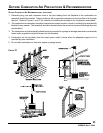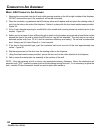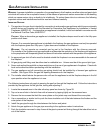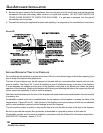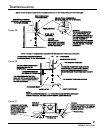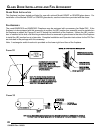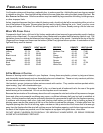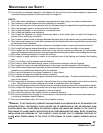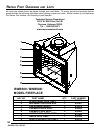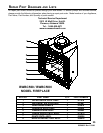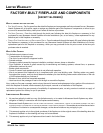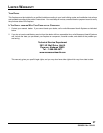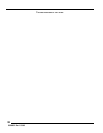Special offers from our partners!

Find Replacement BBQ Parts for 20,308 Models. Repair your BBQ today.

31
MAINTENANCE AND SAFETY
FUEL STORAGE
Wood can be dried sufficiently for burning within a few weeks if protected form rain in a low humidity area. It is
far better to cut wood and allow it to dry for a year. In all cases, the wood should be stacked so that both ends
of the sticks are exposed to the air and protected from rain. The drier the wood, the more usable heat produced
by the fire and less likely rapid accumulation of soot and creosote within the chimney is to occur. See the
section of this manual concerning chimney maintenance for information concerning the hazards of soot a
creosote accumulation. Small quantities of wood required for fire tending must be kept at least 30 inches from
the fireplace.
DISPOSAL OF ASHES
Ashes should be placed in a metal container with a tight fitting lid. The closed container of ashes should be
placed on a noncombustible floor or on the ground well away from all combustible materials pending final
disposal. If the ashes are disposed of by burial in soil or otherwise locally dispersed, they should be retained
in the closed container until all cinder has thoroughly cooled. Ashes should never be placed in a container with
combustible materials.
CHIMNEY MAINTENANCE
Creosote, Formation and Need for Removal: When wood is burned slowly, it produces tar and other organic
vapors, which combine with expelled moisture to form creosote. The creosote vapors condense in the relatively
cool chimney flue of a slow-burning fire. As a result, creosote residue accumulates on the flue lining. When
ignited, this creosote makes an extremely hot fire.
The chimney should be inspected at least twice a year during the heating season to determine if a creosote
buildup has occurred.
If creosote has accumulated it should be removed to reduce the risk of a chimney fire.
The chimney cap can be removed for inspection, maintenance and cleaning by removing three screws from
the support legs and lifting upward.
When the fireplace is first in use, inspect the chimney frequently and clean the chimney any time an accumulation
is observed on the flue walls. The frequency of these inspections can be increased or reduced appropriately
after a pattern of accumulation has been established. Please note, however, that changes in the outside
environmental conditions such as temperature and humidity or changes in the operation of the fireplace can
lead to rapid buildup of soot and/or creosote.
To clean the chimney, obtain the services of a qualified and reputable chimney sweep, or remove the
accumulation with brushes on wooden or fiberglass poles. Do not use metal pipes, chains, wires, etc., to clean
the chimney because such items can scratch the surface of the stainless steel flue which can shorten the life
of the flue and provide a rough surface for soot particles to attach to.
Be sure to cover nearby furnishing and arrange some method of catching soot and creosote particles that may
fall during the chimney cleaning process. If glass doors are installed on the fireplace, they should be closed.
Extra caution must be used to avoid damage to the flue damper during the cleaning process.
In addition to checking and cleaning the chimney on a regular basis, be sure to inspect the chimney before
starting a fire at the beginning of each heating season. Make sure the chimney is clear from any accumulation
of soot, creosote or any other debris, and that all joints are intact.
Monessen Hearth Systems does not recommend chemical cleaners because some may contain elements
that corrode the metal parts of the chimney or fireplace.
53D9032. Rev 1 03/03



